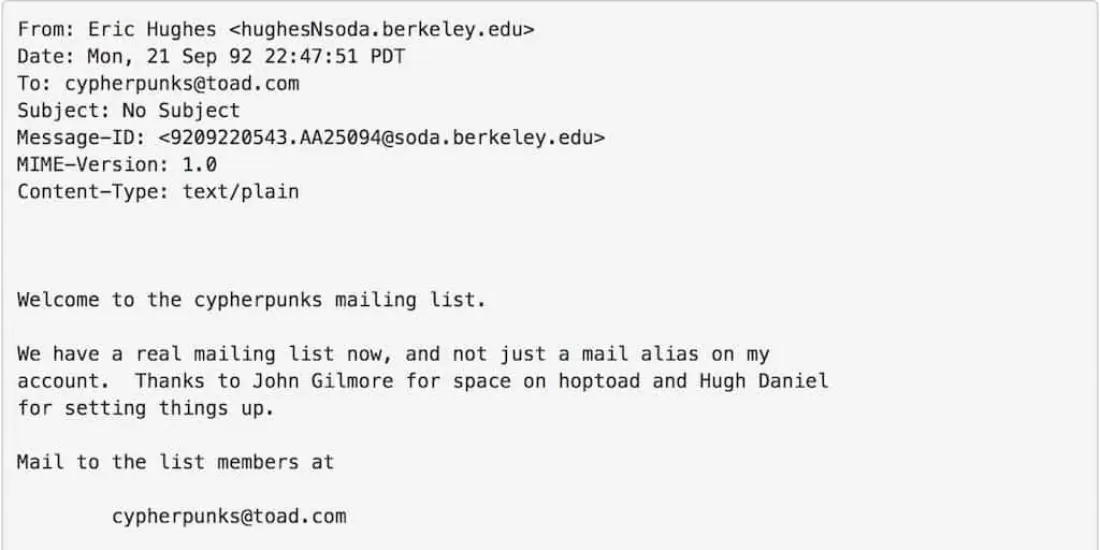CYPHERPUNKS: A MEETING OF MINDS
September 21, 1992
- Artist
- Fact Date
- Fact #
- undefined
- Printing Specifications
- Paper / Stock
- Page Size
Mailing lists may be swerved today but in the 90s were ideal for exchanging ideas. When a bunch of San Fran cryptographers took their informal discussions to the web, the Cypherpunk list was born. A who’s who of early internet pioneers, including Cypherpunk’s Manifesto author Eric Hughes, its members were ahead of their time.
Guest Written by Aaron Van Wirdum
Eric Hughes believed that cryptography was the best way to protect privacy in a digital age. As a math student at Berkeley in the 1980s, he’d learned that governments always found a way to encroach on fundamental rights, but he envisioned a future where software tools could truly help individuals protect their personal information.
When, not long after graduating from the Californian university, he visited his friend Tim May, Hughes found someone who shared that vision. May, by now in his mid-thirties and retired from Intel, and Hughes would spend the following days discussing the revolutionary potential of strong cryptography, and its implications for the future of society.
But the two of them kept running into the same biting issue. While they recognized the great promise of cryptography, none of it was actually materialising.
They decided it was time to change this.
In early 1992, with the help from their friend and co-founder of the Electronic Frontier Foundation (EFF) John Gilmore, Hughes and May invited a group of hackers, cryptographers, and privacy activists from the Bay Area to a gathering in San Francisco.
May read The Crypto Anarchist Manifesto to those in attendance before proceeding to explain the math behind public key cryptography, mix networks, and electronic cash. They spent the rest of the evening exploring the potential of these breakthroughs in cryptography and computing, and how they could affect society.

Those hackers, cryptographers, and privacy activists would come to form the loosely organized technology-activist group calling itself The Cypherpunks, and set out to implement the cryptographic protocols in software.
The Cypherpunks started meeting regularly at different locations in and around San Francisco. And on top of that, they launched a mailing list. With that, anyone with an internet connection anywhere in the world could take part in the conversation.

Within a few years, the Cypherpunk mailing list evolved into an early internet phenomenon. Peaking at around 2,000 subscribers and about as many emails per month, the list grew to become a platform for public discussion about the future of the internet, with a strong emphasis on the Cypherpunk mission of protecting privacy as the information superhighway continued to grow and evolve. Most important of all, it was a place where the Cypherpunks could share their projects. As Hughes had explained in A Cypherpunk’s Manifesto — which he’d published shortly after co-founding the group — “Cypherpunks write code.”
Indeed, they did. One of the first successful Cypherpunk projects was the creation of a remailer, which allowed people to obfuscate their email metadata, while Phil Zimmerman’s Pretty Good Privacy (PGP) project — which for the first time allowed internet users to communicate privately — was eagerly adopted by the movement as well.
And last but not least — in what was a holy grail for the Cypherpunks — they started experimenting with electronic cash: forms of digital money that could be used over the internet anonymously.
- Artist
- XXXXX
- BTC On this day
- September 21, 1992
- Circulating Supply
- 0
- Market Cap
- $0
- Number of Addresses
- 0
- Block Number
- 0
- Block Size
- 0
- Hash Rate
- undefined TH/s
